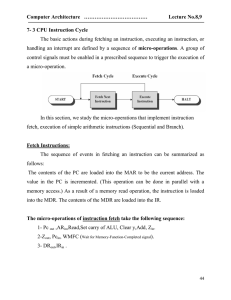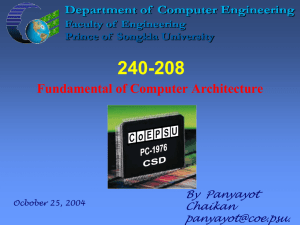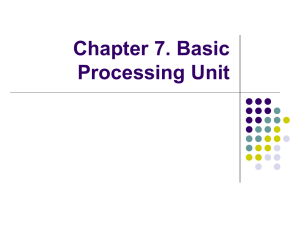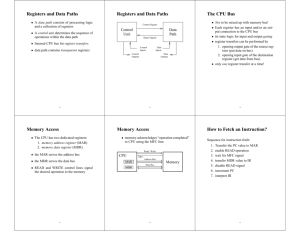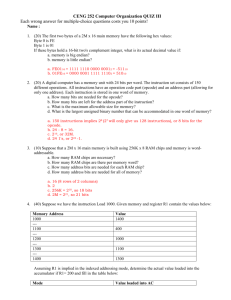Chapter 7 – Basic Processing Unit
advertisement
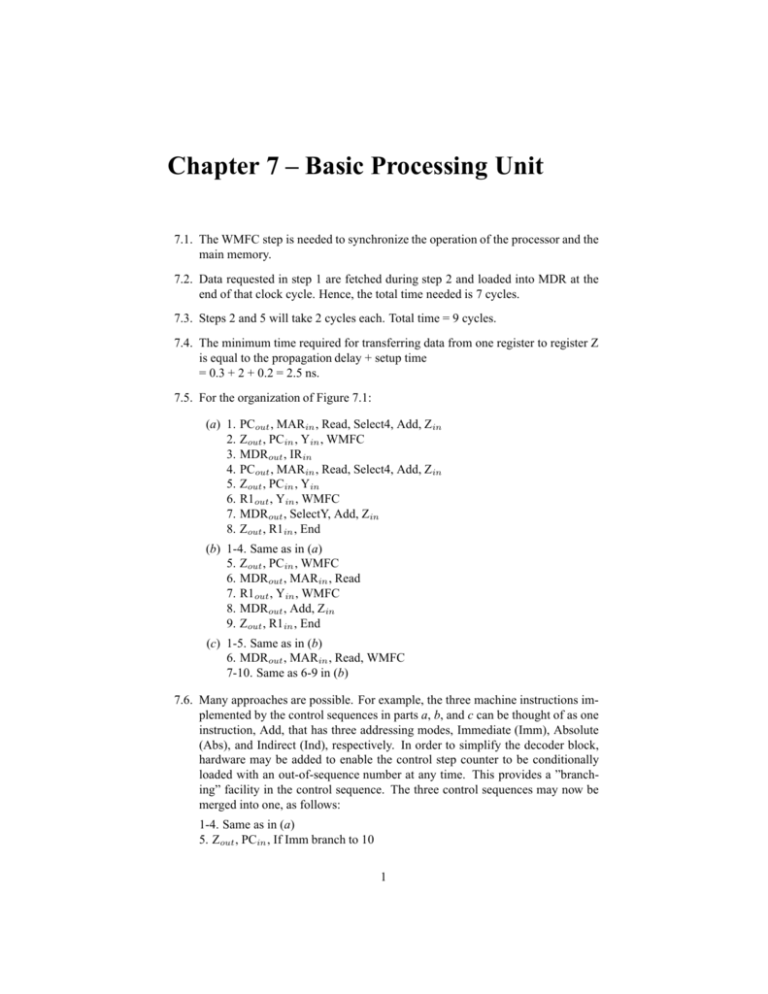
Chapter 7 – Basic Processing Unit
7.1. The WMFC step is needed to synchronize the operation of the processor and the
main memory.
7.2. Data requested in step 1 are fetched during step 2 and loaded into MDR at the
end of that clock cycle. Hence, the total time needed is 7 cycles.
7.3. Steps 2 and 5 will take 2 cycles each. Total time = 9 cycles.
7.4. The minimum time required for transferring data from one register to register Z
is equal to the propagation delay + setup time
= 0.3 + 2 + 0.2 = 2.5 ns.
7.5. For the organization of Figure 7.1:
(a) 1. PCout , MARin , Read, Select4, Add, Zin
2. Zout , PCin , Yin , WMFC
3. MDRout , IRin
4. PCout , MARin , Read, Select4, Add, Zin
5. Zout , PCin , Yin
6. R1out , Yin , WMFC
7. MDRout , SelectY, Add, Zin
8. Zout , R1in , End
(b) 1-4. Same as in (a)
5. Zout , PCin , WMFC
6. MDRout , MARin , Read
7. R1out , Yin , WMFC
8. MDRout , Add, Zin
9. Zout , R1in , End
(c) 1-5. Same as in (b)
6. MDRout , MARin , Read, WMFC
7-10. Same as 6-9 in (b)
7.6. Many approaches are possible. For example, the three machine instructions implemented by the control sequences in parts a, b, and c can be thought of as one
instruction, Add, that has three addressing modes, Immediate (Imm), Absolute
(Abs), and Indirect (Ind), respectively. In order to simplify the decoder block,
hardware may be added to enable the control step counter to be conditionally
loaded with an out-of-sequence number at any time. This provides a ”branching” facility in the control sequence. The three control sequences may now be
merged into one, as follows:
1-4. Same as in (a)
5. Zout , PCin , If Imm branch to 10
1
6. WMFC
7. MDRout , MARin , Read, If Abs branch to 10
8. WMFC
9. MDRout , MARin , Read
10. R1out , Yin , WMFC
11. MDRout , Add, Zin
12. Zout , R1in , End
Depending on the details of hardware timing, steps, 6 and 7 may be combined.
Similarly, steps 8 and 9 may be combined.
7.7. Following the timing model of Figure 7.5, steps 2 and 5 take 16 ns each. Hence,
the 7-step sequence takes 42 ns to complete, and the processor is idle 28/42 =
67% of the time.
7.8. Use a 4-input multiplexer with the inputs 1, 2, 4, and Y.
7.9. With reference to Figure 6.7, the control sequence needs to generate the Shift
right and Add/Noadd (multiplexer control) signals and control the number of
additions/subtractions performed. Assume that the hardware is configured such
that register Z can perform the function of the accumulator, register TEMP can
be used to hold the multiplier and is connected to register Z for shifting as shown.
Register Y will be used to hold the multiplicand. Furthermore, the multiplexer
at the input of the ALU has three inputs, 0, 4, and Y. To simplify counting, a
counter register is available on the bus. It is decremented by a control signal
Decrement and it sets an output signal Zero to 1 when it contains zero. A facility
to place a constant value on the bus is also available.
After fetching the instruction the control sequence continues as follows:
4.
5.
6.
7.
8.
9.
Constant=32, Constantout , Counterin
R1out , TEMPin
R2out , Yin
Zout , if TEMP0 = 1 then SelectY else Select0, Add, Zin , Decrement
Shift, if Zero=0 then Branch 7
Zout , R2in , End
7.10. The control steps are:
1-3. Fetch instruction (as in Figure 7.9)
4. PCout , Offset-field-of-IRout, Add, If N = 1 then PCin , End
2
7.11. Let SP be the stack pointer register. The following sequence is for a processor
that stores the return address on a stack in the memory.
1-3. Fetch instruction (as in Figure 7.6)
4. SPout , Select4, Subtract, Zin
5. Zout , SPin , MARin
6. PCout , MDRin , Write, Yin
7. Offset-field-of-IRout, Add, Zin
8. Zout , PCin , End, WMFC
7.12. 1-3. Fetch instruction (as in Figure 7.9)
4. SPoutB , Select4, Subtract, SPin , MARin
5. PCout , R=B, MDRin , Write
6. Offset-field-of-IRout, PCout , Add, PCin , WMFC, End
7.13. The latch in Figure A.27 cannot be used to implement a register that can be both
the source and the destination of a data transfer operation. For example, it cannot
be used to implement register Z in Figure 7.1. It may be used in other registers,
provided that hold time requirements are met.
7.14. The presence of a gate at the clock input of a flip-flop introduces clock skew.
This means that clock edges do not reach all flip-flops at the same time. For
example, consider two flip-flops A and B, with output QA connected to input
DB. A clock edge loads new data into A, and the next clock edge transfers these
data to B. However, if clock B is delayed, the new data loaded into A may reach
B before the clock and be loaded into B one clock period too early.
QA
QB
ClockA
ClockB
ClockA
QA
ClockB
skew
In the absence of clock skew, flip-flop B records a 0 at the first clock edge.
However, if Clock B is delayed as shown, the flip-flop records a 1.
3
7.15. Add a latch similar to that in Figure A.27 at each of the two register file outputs.
A read operation is performed in the RAM in the first half of a clock cycle and
the latch inputs are enabled at that time. The data read enter the two latches and
appear on the two buses immediately. During the second phase of the clock the
latch inputs are disabled, locking the data in. Hence, the data read will continue
to be available on the buses even if the outputs of the RAM change. The RAM
performs a write operation during this phase to record the results of the data
transfer.
Bus A
Bus B
Bus C
RAM
Read Write
Enablein
Clock
Read
Write
Enablein
7.16. The step counter advances at the end of a clock period in which Run is equal
to 1. With reference to Figure 7.5, Run should be set to 0 during the first clock
cycle of step 2 and set to 1 as soon as MFC is received. In general, Run should
be set to 0 by WMFC and returned to 1 when MFC is received. To account for
the possibility that a memory operation may have been already completed by
the time WMFC is issued, Run should be set to 0 only if the requested memory
operation is still in progress. A state machine that controls bus operation and
generates the run signal is given below.
Write
C
Read
A
MFC
B
MFC
Run = WNFC ⋅ (B + C)
4
7.17. The following circuit uses a multiplexer arrangement similar to that in Figure
7.3.
00
0
01
1
10
D
Q
R M
Clock
7.18. A possible arrangement is shown below. For clarity, we have assumed that MDR
consists of two separate registers for input and output data. Multiplexers Mux-1
and Mux-2 select input B for even and input A for odd byte operations. Mux
3 selects input A for word operations and input B for byte operations. Input
B provides either zero extension or sign extension of byte operands. For signextension it should be connected to the most-significant bit output of multiplexer
Mux-2.
Memory bus
MDRH (in)
MDRL (in)
MDRH (out)
MDRL (out)
Zero or
Sign ext.
B
A
Mux 3
B
A
Mux 1
Mux 2
B
A
7.19. Use the delay element in a ring oscillator as shown below. The frequency of
oscillation is 1/(2T). By adding the control circuit shown, the oscillator will run
only while Run is equal to 1. When stopped, its output A is equal to 0. The
oscillator will always generate complete output pulses. If Run goes to 0 while A
is 1, the latch will not change state until B goes to 1 at the end of the pulse.
5
Delay T
Ring oscillator
Output
Run
Output
Ring oscillator
with run/stop control
Delay T
7.20. In the circuit below, Enable is equal to 1 whenever Short/Long is equal to 1,
indicating a short pulse. When this line changes to 0, Enable changes to 0 for
one clock cycle.
Short/Long
Enable
D
Clock
Clock
Short/Long Q
0
0
D
1
0
1
0
1
0
0
1
1
0
Short/Long
D
Q
Enable
6
Q
7.21. (a) Count sequence is: 0000 1000 1100 1110 1111 0111 0011 0001 0000
(b) A 5-bit Johnson counter is shown below, with the outputs Q 1 to Q5 decoded
to generate the signals T1 to T10 . The feed back circuit has been modified to
make the counter self-starting. It implements the function
D1 = Q5 + Q3 + Q4
This circuit detects states that have Q3 Q4 Q5 = 010 and changes the feedback
value from 1 to 0. Without this or a similar modification to the feedback circuit,
the counter may be stuck in sequences other than the desired one above.
The advantage of a Johnson counter is that there are no glitches in decoding the
count value to generate the timing signals.
D
Q
D
Q
D
Q
T5
T6
T7
T0
T1
T2
D
Q
D
T8
T3
Q
T9
T4
7.22. We will generate a signal called Store to recirculate data when no external action
is required.
Store
=
(ARS + LSR + SL + LLD)
D15
=
ASR · Q15 + SL · Q14 + ROR · Carry + LD · D15 + Store ·Q15
D1
=
(ASR + LSR + ROR) · Q2 + SL · Q0 + LD · D1 + Store ·Q1
D0
=
(ASR + LSR + ROR) · Q1 + LD · D0 + + Store ·Q0
7
7.23. A state diagram for the required controller is given below. This is a Moore
machine. The output values are given inside each state as they are functions of
the state only.
Since there are 6 independent states, a minimum of three flip-flops r, s, and t
are required for the implementation. A possible state assignment is shown in the
diagram. It has been chosen to simplify the generation of the outputs X, Y, and
Z, which are given by
X = r + s + t
Y = s
Z = t
Using D flip-flops for implementation of the controller, the required inputs to the
flip-flops may be generated as follows
D(r)
=
stB+st
D(s)
=
stA+stB
D(t)
=
stB+stA+stB
B
S0
111
S0
110
Initialization
A
S0
000
S0
100
A
rst
S0
001
B
8
S0
101
7.24. Microroutine:
Address
(Octal)
Microinstruction
000-002
300
161
162
163
164
165
166
170-173
Same as in Figure 7.21
µBranch {µPC ← 161
PCout , MARin , Read, Select4, Add, Zin
Zout , PCin , WMFC
MDRout , Yin
Rsrcout , SelectY, Add, Zin
Zout , MARin , Read
µBranch {µPC ← 170; µPC0 ← [IR8 ]}, WMFC
Same as in Figure 7.21
7.25. Conditional branch
Address
(Octal)
Microinstruction
000-002
003
300
301
302
303
Same as in Figure 7.21
µBranch {µPC ← 300
if Z+(N⊕V = 1 then µBranch {µPC ← 304}
PCout , Yin
Addressout , SelectY, Add, Zin
Zout , PCin , End
7.26. Assume microroutine starts at 300 for all three instructions. (Altenatively, the
instruction decoder may branch to 302 directly in the case of an unconditional
branch instruction.)
Address
(Octal)
Microinstruction
000-002
003
300
301
302
303
304
Same as in Figure 7.21
µBranch {µPC ← 300}
if Z+(N⊕V = 1) then µBranch {µPC ← 000}
if (N = 1) then µBranch {µPC ← 000}
PCout , Yin
Offset-field-of-IRout, SelectY, Add, Zin
Zout , PCin , End
9
7.27. The answer to problem 3.26 holds in this case as well, with the restriction that
one of the operand locations (either source or destination) must be a data register.
Address
(Octal)
Microinstruction
000-002
003
010
011
012
013
014
121
122
123
124
170-173
Same as in Figure 7.21
µBranch {µPC ← 010}
if (IR10−8 = 000) then µBranch {µPC ← 101}
if (IR10−8 = 001) then µBranch {µPC ← 111}
if (IR10−9 = 01) then µBranch {µPC ← 121}
if (IR10−9 = 10) then µBranch {µPC ← 141}
µBranch {µPC ← 161}
Rsrcout , MARin , Read, Select4, Add, Zin
Zout , Rsrcin
if (IR8 = 1) then µBranch {µPC ← 171}
µBranch {µPC ← 170}
Same as in Figure 7.21
7.28. There is no change for the five address modes in Figure 7.20. Absolute and Immediate modes require a separate path. However, some sharing may be possible
among absolute, immediate, and indexed, as all three modes read the word following the instruction. Also, Full Indexed mode needs to be implemented by
adding the contents of the second register to generate the effective address. After
each memory access, the program counter should be updated by 2, rather than 4,
in the case of the 16-bit processor.
7.29. The same general structure can be used. Since the dst operand can be specified
in any of the five addressing modes as the src operand, it is necessary to replicate the microinstructions that determine the effective address of an operand. At
microinstruction 172, the source operand should placed in a temporary register
and another tree of microinstructions should be entered to fetch the destination
operand.
10
7.30. (a) A possible address assignment is as follows.
Address
Microinstruction
0000
0001
0010
0011
0100
0101
0110
0111
1000
1001
1010
1011
1100
1101
1110
1111
A
B
if (b6 b5 ) = 00) then µBranch 0111
if (b6 b5 ) = 01) then µBranch 1010
if (b6 b5 ) = 10) then µBranch 1100
I
µBranch 1111
C
D
µBranch 1111
E
µBranch 1111
F
G
H
J
(b) Assume that bits b6−5 of IR are ORed into bit µPC3−2
Address
Microinstruction
0000
0001
0010
0011
0100
0101
0110
0111
1011
1100
1101
1110
1111
A
B; µPC3−2 ← b6−5
C
D
µBranch 1111
E
µBranch 1111
F
G
H
µBranch 1111
I
J
11
(c)
Address
0000
0001
0010
0011
0110
1010
1011
1100
1110
1111
Microinstruction
Next address
Function
0001
0010
0011
1111
1111
1011
1100
1111
1111
–
A
B; µPC3−2 ← b6−5
C
D
E
F
G
H
I
J
7.31. Put the Yin control signal as the fourth signal in F5, to reduce F3 by one bit.
Combine fields F6, F7, and F8 into a single 2-bit field that represents:
00:
01:
10:
11:
Select4
SelectY
WMFC
End
Combining signals means that they cannot be issued in the same microinstruction.
7.32. To reduce the number of bits, we should use larger fields that specify more signals. This, inevitably, leads to fewer choices in what signals can be activated at
the same time. The choice as to which signals can be combined should take into
account what signals are likely to be needed in a given step.
One way to provide flexibility is to define control signals that perform multiple
functions. For example, whenever MAR is loaded, it is likely that a read command should be issued. We can use two signals: MARin and MARin · Read. We
activate the second one when a read command is to be issued. Similarly, Z in is
always accompanied by either Select Y or Select4. Hence, instead of these three
signals, we can use Zin · Select4 and Zin · SelectY.
A possible 12-bit encoding uses three 4-bit fields FA, FB, and FC, which combine signals from Figure 7.19 as follows:
FA: F1 plus, Zout · End, Zout · WMFC. (11 signals)
FB: F2, F3, Instead of Zin , MARin , and MDRin use Zin ·Select4, Zin ·SelectY,
MARin , MARin · Read, and MDRin · Write. (13 signals)
FC: F4 (16 signals)
12
With these choices, step 5 in Figure 7.6 must be split into two steps, leading to
an 8-step sequence. Figure 7.7 remains unchanged.
7.33. Figure 7.8 contains two buses, A and B, one connected to each of the two inputs
of the ALU. Therefore, two fields are needed instead of F1; one field to provide
gating of registers onto bus A, and another onto bus B.
7.34. Horizontal microinstructions are longer. Hence, they require a larger microprogram memory. A vertical organization requires more encoding and decoding
of signals, hence longer delays, and leads to longer microprograms and slower
operation. With the high-density of today’s integrated circuits, the vertical organization is no longer justified.
7.35. The main advantage of hardwired control is fast operation. The disadvantages
include: higher cost, inflexibility when changes or additions are to be made, and
longer time required to design and implement such units.
Microprogrammed control is characterized by low cost and high flexibility. Lower
speed of operation becomes a problem in high-performance computers.
13
